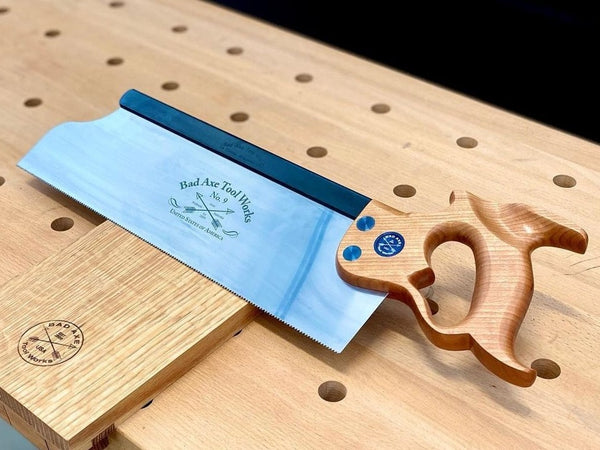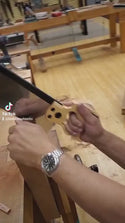Current lead time: 6-8 weeks depending on customizations. Call or email info@badaxetoolworks.com for more accurate lead times.
Read Fine Woodworking's Review HERE
Welcome to Bad Axe's interpretation of the highly sought-after Disston No. 9 Back Saw with the 1874 Reagan patent ergonomic handle and distinctive ogee-curved exposed toe at the toothline. We are proud to introduce our improved version of this esteemed saw, as it marks the beginning of our revival of other treasured tools from, what we consider, saw making's golden age.
The Bad Axe No. 9 is meticulously crafted to excel in woodworking projects that demand precise joinery in tight spaces. The exposed ogee-curved plate at the toe end of the allows for cutting in tight places, such as cleaning out the mortises for half-lapping dovetailed joints into beams, boat-building, and other like-type requirements where the sawback will obstruct the cut, while at the same time retaining full functionality of a 14" toothline for medium tenon cheek ripping requirements, offcuts, dadoes, and rabbets. This is an incredibly versatile saw.
Featuring a pitch of 12 teeth per inch (ppi), the Bad Axe No. 9 ensures a fine and efficient cutting action. The recommended Hybrid filing provides the perfect balance between rip and crosscut capabilities, making it suitable for a wide range of woodworking tasks. The .025" plate thickness ensures rigidity and stability, allowing for precise control while sawing.
With a kerf of .032", the Bad Axe No. 9 creates a clean and narrow cut, minimizing material waste and promoting accuracy. Its impressive depth of cut, measuring 3 5/8 inches, enables you to tackle various joinery tasks with ease and precision.
While the Bad Axe No. 9 thrives in specialized joinery work, it remains fully functional as a versatile backsaw for a wide range of applications. Whether you're crafting tenons, cutting dadoes, or creating intricate detail work, this saw delivers outstanding performance and reliability.
I have a healthy dose of skepticism when it comes to 'improved' pattern tools. Sometimes the improvement is functional and sometimes it's just cosmetic. In case of this saw, I think it may be both. The historical No. 9 design certainly is beautiful and will part some with their money on that count alone, but after using it for a week I've found that it does shift the weight of the saw back toward the handle giving it a nice sense of balance. I've been using it as a sort of hybrid carcase/sash saw, and I've yet to find something to complain about. Compared to other saws, I found a higher percentage of cuts with the No.9 to be straight and square straight off the saw.



























